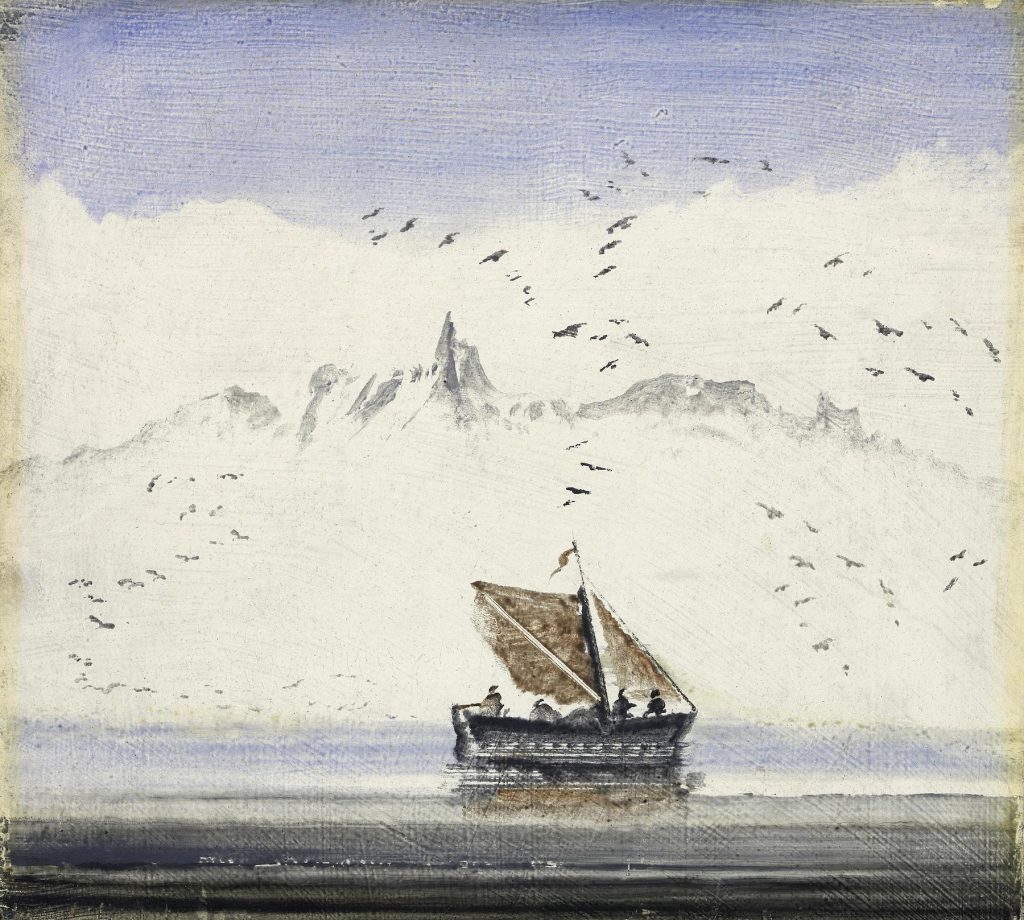Peder Balke (Hedemarken, Norway 1804 - 1887 Christiania)
Norwegian Coastal Landscape with a Sailing Boat, c. 1870
Oil on paper mounted on cardboard, 16.5 x 18.4 cm
On the verso a label printed with the address C.W. Blomqvist’s Kunstutstilling, Tordenskioldsgt.5/Oslo (1914-20) and annotated Peder Balke / Nr. A542;
With an additional, later label bearing an almost identical annotation;
Inscribed on the frame 14.Aug 1884 fra ……… P Balke
Provenance:
With art dealer C.W. Blomqvist, 1914-20
Private collection, Norway
Exhibited:
C.W. Blomqvist’s Kunstutstilling, 1914-20
The Norwegian artist Peder Balke occupies a somewhat unique position in early nineteenth-century painting. The striking modernity of his work is widely recognized. Indeed, art historians now draw interesting comparisons with the work of Caspar David Friedrich and J. M. W. Turner.[1] A number of artists working today have reported finding his techniques intellectually stimulating.[2]
Balke received his early training in Norway. The absence of an academy of art caused him to leave the country in 1828 for Stockholm. In 1830 he visited Copenhagen where the paintings of J. C. Dahl impressed him greatly. In 1831 he embarked on his first journey to northern Norway. He visited the North Cape, first saw the midnight sun and experienced extreme weather conditions.
In 1835, after staying in Dresden for several months with Friedrich and Johan Clausen Dahl, Balke travelled on to Paris where he met his fellow countryman, the painter Thomas Fearnley. Both were particular admirers of Eugène Isabey, Théodore Gudin and Horace Vernet. As Marit Lange writes: The balance between a directly observed rendering of nature and a subjective, symbolic perception of it was to be a permanent feature of Balke’s art from then on.[3] Balke moved to Paris in 1844. He managed to obtain an audience with Louis-Philippe who had visited the north of Norway in his youth and was therefore eager to meet him. Balke showed the king the sketches of northern Norway he had brought with him to Paris and Louis-Philippe selected thirty to be worked up into paintings. Twenty-six of them are on permanent exhibition at the Louvre. Balke’s future as an artist seemed secure, but the unstable political situation in Paris put an end to the King’s plans and forced Balke to leave for London in 1849. He studied the work of Turner and this contributed to the growing radical tendencies of his style. By 1850 he was back in Norway. He joined a socialist worker’s movement and took on a number of social and political commitments. Despite his lack of public recognition as an artist, he continued to paint.
Balke’s late work, of which this painting is an outstanding example, clearly establishes his reputation as a ‘pioneer of modernism’. In the 1850s he began to devote his energies to developing his highly distinctive wet-on-wet technique. He employs this technique to masterly effect in the present painting. The work also displays all the characteristics of his late period. Typical features of this late period are a reduced thematic vocabulary and a concentration on unusual natural phenomena to create bizarre perspectival effects. Examples in the present painting are the ghostly apparition of the ill-defined mountainside looming in the background and set against it, the sailing boat accompanied by a swarm of circling birds. This device defines the middle ground as the boat appears to float above the water on shimmering bands of icy mist.
Balke began to use white grounds in the late 1850s. Avoiding impasto, he applied thin layers of diluted paint with a brush, a sponge or his fingertips. The transparency of his brushwork allows the ground to show through, creating the effect of white heightening. Forms are subtly delineated and the white ground lends his work compositional balance, creating subtle effects of light and depth.[4]
It is something of a paradox that it was the paintings that were executed towards the end of Balke’s life – like the present work – that were to win him the prominent position he holds today in the history of Norwegian art.
[1] Peder Balke 1804-1887, exhib. cat., Oslo, Kunstnernes Hus, 1954; P. Kvaerne and M. Malmanger (eds.), Un peintre norvégien au Louvre. Peder Balke (1804-1887) et son temps, Oslo, Instituttet for sammenlignende kulturforskning, 2006; Peder Balke. Ein Pionier der Moderne, exhib. cat., Kunsthalle Krems, 7.9.2008-15.2.2009 and Ordrupgaard Copenhagen, 5.3.2009-21.7.2009, Krems/Vienna/Bonn 2008. [2] Per Kirkeby, Peder Balke, Trick, Depth and Game, Hellerup 1996. [3] P. Kvaerne and M. Malmanger, op. cit., p.35. [4] See Marit Ingeborg Lange in Un peintre norvégien au Louvre ….., P. Kvaerne and M. Malmanger (eds.), op. cit., pp. 51-4 and Buchhart in Peder Balke, op. cit., pp.28-45.

